How to Choose Down Milling and Up Milling When Processing Parts?
In the process of using CNC machine tools, how to make the right choice for down milling and up milling?
How to define down milling and up milling?
As shown in the figure below, the cutting speed of the tool is the same as the moving direction of the workpiece is down milling, and the cutting speed of the tool is opposite to the moving direction of the workpiece is up milling.
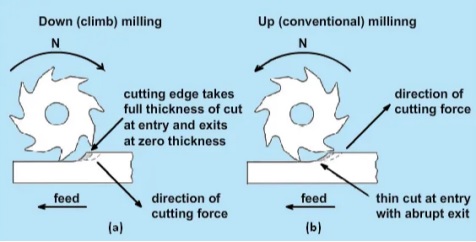
When milling the outer contour of the workpiece, feed clockwise along the outer contour of the workpiece, programming means down milling, and program in the counterclockwise direction along the outer contour of the workpiece, and feed means up milling; when milling the inner contour of the workpiece, follow the inner contour of the workpiece The counterclockwise feed and programming are down milling, and the clockwise programming along the inner contour of the workpiece is up-cut milling.
Features of down milling and up milling
1. Effect on cutting force
The vertical cutting component force acting on the workpiece during up milling is always upward, which tends to lift the workpiece, which is easy to cause vibration and affect the clamping of the workpiece. This situation is particularly prominent when milling thin-walled and poorly rigid workpieces.
The vertical cutting component force acting on the workpiece during down milling always presses down the workpiece, which is beneficial to the clamping of the workpiece.
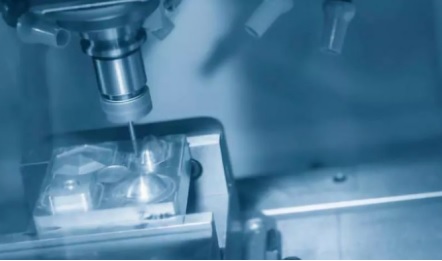
2. Effect on tool elastic deformation
When an end mill is used to down-mill the contour of a workpiece, the reaction force of the workpiece on the tool points to the direction of the tool, and the elastic deformation of the tool causes the tool to "give the tool" (undercut) phenomenon.
When an end mill is used to up-mill the contour of a workpiece, the reaction force of the workpiece on the tool points to the inside of the contour, and the elastic deformation of the tool causes the tool to "gnaw" (overcut). The smaller the diameter of the tool and the longer the shank is, the more obvious the phenomenon of "letting the knife" and "biting the knife".
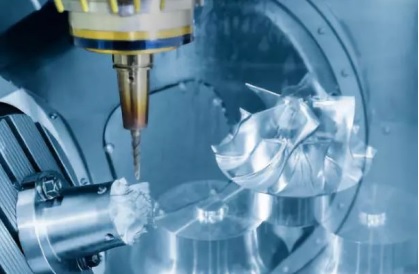
Therefore, when the rough machining adopts down milling, the finishing allowance can be kept less. When using up-cut milling for rough machining, more finishing allowance must be left to prevent the workpiece from being scrapped due to "gnawing".
3. Effect on tool wear
The vertical milling component force of down milling presses the workpiece to the worktable, the cutter teeth slide with the machined surface, and the friction is small, which is beneficial to reduce the wear of the cutter teeth, reduce the work hardening phenomenon and reduce the surface roughness.
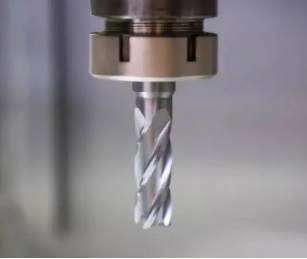
In addition, the cutting thickness of the cutter teeth during down milling is from maximum to zero, so that the impact force of the cutter teeth when cutting into the workpiece is relatively large, especially when the workpiece surface to be processed is rough or has a hard surface, the tool will produce greater vibration. .
However, during down milling, the distance that the cutter travels on the workpiece is shorter than that of up milling, and the average cutting thickness is larger. Therefore, under the same cutting conditions, when up-milling is used, the tool is easy to wear and consumes more cutting power.
How to choose down milling and up milling?
1. Selection principle
When using down milling, the machine tool is first required to have a gap elimination mechanism, which can reliably eliminate the gap between the feed screw and the nut of the worktable to prevent vibration during the milling process.
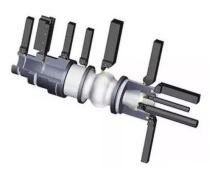
It is ideal if the worktable is driven by hydraulic pressure. Secondly, it is required that there is no hard skin on the surface of the workpiece blank, and the process system must have sufficient rigidity. If the above conditions can be met, down milling should be used as much as possible, especially for milling difficult-to-machine materials. Down milling can reduce cutting deformation, cutting force and cutting power.
When parts are roughed, up-milling is usually used; when finishing, in order to prevent "biting", down-milling is usually used.
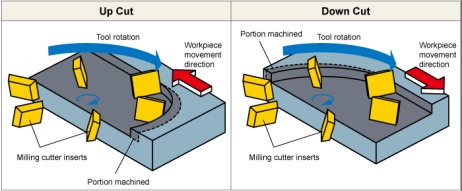
2. Relationship with tool radius compensation
When contour milling is performed on a CNC machine tool, tool radius compensation is often used for programming and processing. The tool radius compensation is divided into tool radius left compensation and tool radius right compensation.
The judgment method of tool radius left compensation is: the tool rotates clockwise (clockwise rotation), and the tool is located on the left side of the machining contour when viewed in the forward direction of the tool. On the contrary, the tool is located on the right side of the machining contour. This compensation method is called tool radius right compensation.
Therefore, regardless of the inner contour or the outer contour processing, the processing method of milling with left tool radius compensation programming is down milling, and the processing method of milling using tool radius right compensation programming is up milling.
When the disk milling cutter is used to process the plane profile, when the cutting width of the tool is greater than 50% of the tool diameter, there are both down milling and up milling in the cutting process.
3. Choice of Down Milling and Up Milling on CNC Milling Machine
CNC machine tools generally have an anti-backlash function, the backlash of the transmission mechanism is small, and most of the CNC machine tools perform parts finishing. Therefore, down-milling is usually used in CNC milling, that is, the tool radius left compensation is used for programming and processing during contour processing.


